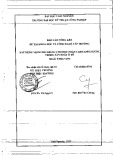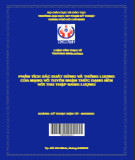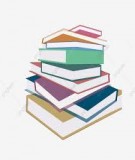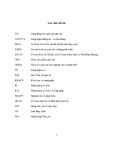
The heterogeneity of mast cell tryptase from human lung and skin
Differences in size, charge and substrate affinity
Qi Peng
1
, Alan R. McEuen
1
, R. Christopher Benyon
2
and Andrew F. Walls
1
1
Immunopharmacology Group and
2
Tissue Remodelling and Repair, University of Southampton School of Medicine,
Southampton General Hospital, Southampton, UK
There has long been conjecture over the degree to which there
may be structural and functional heterogeneity in the tetra-
mericserineproteasetryptase(EC3.4.21.59),amajor
mediator of allergic inflammation. We have applied 2D gel
electrophoresis to analyze the extent, nature, and variability
of this heterogeneity in lysates of mast cells isolated from lung
and skin, and in preparations of purified tryptase. Gels were
silver stained, or the proteins transferred to nitrocellulose
blots and probed with either tryptase-specific monoclonal
antibodies or various lectins. Tryptase was the major protein
constituent in mast cell lysates, and presented as an array of
9–12 diffuse immunoreactive spots with molecular masses
ranging from 29 to 40 kDa, and pI values from 5.1 to 6.3.
Although the patterns obtained for lung and skin tryptase
were broadly similar, differences were observed between
tissues and between individual donors. Lectin binding studies
indicated the presence of mono-antennary or bi-antennary
complex-type oligosaccharide with varying degrees of
sialylation. Deglycosylation with protein-N-glycosidase
F (PNGase F) reduced the size of both lung and skin
tryptase, while incubation with PNGase F or neuramini-
dase narrowed the pI range, indicating variable degrees of
glycosylation as a major contributor to the size and
charge heterogeneity. Comparison of different purified
preparations of lung and skin tryptase revealed no significant
difference in pH profiles, but differences were seen in
reactivity towards a range of chromogenic substrates, with
substantial differences in K
m
,k
cat
and degree of coopera-
tivity. Mathematical modeling indicated that the variety in
kinetics parameters could not result solely from the sum of
varying amounts of isoforms obeying Michaelis–Menten
kinetics but with different values of K
m
and k
cat
.The
heterogeneity demonstrated for tryptase in these studies
suggests that there are important differences in tryptase
function in different tissues.
Keywords: mast cell; tryptase; glycosylation; lectin; 2D gel
electrophoresis.
Tryptase (EC 3.4.21.59) is a serine protease of mast cell
origin with trypsin-like substrate specificity [1,2]. Upon
activation of these cells with allergen or other stimuli, it is
released along with other potent mediators of inflammation
including other neutral proteases, histamine, proteoglycans,
eicosanoids and cytokines. Its actions on peptides [3,4],
proteins [5,6], cells [7–11] and tissues [12,13] are consistent
with a pro-inflammatory role in allergic disease, and
inhibitors of tryptase have proved efficacious in animal
and human models of asthma [14,15].
Although tryptase is generally referred to as a single
enzyme, heterogeneity has been observed at both the
structural [16–20] and functional [21,22] level of the protein.
Unusually for a serine protease, tryptase exists as a tetramer
of approximately 130 kDa [23]. The earliest reports on this
enzyme indicated microheterogeneity of the subunits, with
molecular masses ranging from 31 to 38 kDa on SDS/
PAGE gels, sometimes as a broad, diffuse band, sometimes
as discrete bands. Both high and low molecular mass forms
have been found to possess an enzymatically active site
capable of being labeled by [
3
H]diisopropyl fluoro-
phosphate ([
3
H]DFP) [17], while Western blotting with
various antibodies has demonstrated extensive antigenic
similarities [19,24]. Treatment with protein-N-glycosidase F
(PNGase F) reduced the apparent molecular mass of the
subunits in tryptase purified from pituitary [18] and from
skin [20], but not from lung [16,18]. Differences in reactivity
towards synthetic peptide substrates and inhibitors have
been reported between tryptase purified from lung and that
purified from skin [21] (although a subsequent comparison
has failed to confirm such differences [25]). Functional
differences were also noticed between two isoforms of lung
tryptase which cleaved high molecular weight kininogen and
vasoactive intestinal peptide at different sites and at different
rates [22].
Correspondence to A. F. Walls, Immunopharmacology Group,
Mailpoint 837, F Level South Block, Southampton General Hospital,
Southampton SO16 6YD, UK.
Fax: +44 23 80796979, Tel.: +44 23 80796151,
E-mail: a.f.walls@soton.ac.uk
Abbreviations: Con A, concanavalin A; DFP, diisopropyl fluoro-
phosphate; FBS, fetal bovine serum; <Glu-,
L
-pyroglutamyl-; MAA,
Maackia amurensis agglutinin; MEM, minimal essential medium;
MeOCO-, N
a
-methoxycarbonyl-; MUGB, 4-methylumbelliferyl-p-
guanidinobenzoate; PHA-L, phytohemagglutinin-L; Pip-, pipecolyl-;
PNGase F, protein-N-glycosidase F; SNA, Sambucus nigra agglutinin;
SNP, single nucleotide polymorphism; Suc-, N
a
-succinyl-;
WGA, wheat germ agglutinin.
Enzyme: serine protease tryptase (EC 3.4.21.59).
Note: a web site is available at http://www.som.soton.ac.uk/research/
rcmb/groups/mast-baso.htm
(Received 16 April 2002, revised 12 November 2002,
accepted 21 November 2002)
Eur. J. Biochem. 270, 270–283 (2003) FEBS 2003 doi:10.1046/j.1432-1033.2003.03385.x

Initially, four different cDNA sequences were identified,
a-andb-tryptase from a human lung mast cell library
[26,27] and tryptases I, II and III, from a skin library [28].
Tryptase II and b-tryptase were found to be identical and to
share 98% identity with tryptases I and III, but only 90%
with a-tryptase. Consequently, tryptases I, II, and III have
been considered together as the b-tryptases but distin-
guished as bI, bII, and bIII. Subsequent genomic sequencing
has identified additional tryptase-like genes which have been
designated c-, d-, and e-tryptases [29–32], but these do not
appear to be secreted by mast cells: c-tryptase (also known
as trans-membrane tryptase) is membrane-bound [30,31],
d-tryptase (also known as mMCP-7-like protease) appears
to be a pseudogene [30,33,34], and e-tryptase is a product of
fetal lung epithelial cells [32]. In contrast, most preparations
of tissue mast cells contain ample mRNA encoding both
a-andb-tryptases [35]. a-Tryptase appears to be released
constitutively from mast cells as the pro-form while the
b-tryptases are stored and subsequently released in the
mature form on anaphylactic degranulation [36,37]. Data
accruing from the Human Genome Project indicate that the
four secreted mast cell tryptases, a,bI, bII, and bIII, are
confined to two genetic loci with aand bI competing
allelically at one locus and bII and bIII competing allelically
at the other [30,34].
All four deduced amino acid sequences predict a poly-
peptide chain of approximately 27.5 kDa, so the experi-
mentally observed subunit molecular masses of 30–38 kDa
are indicative of extensive post-translational modification.
Consistent with these observations is the presence of two
consensus N-glycosylation sites in a-andbI-tryptase, and
one such site in bII- and bIII-tryptase [27,28]. Interestingly,
a single nucleotide polymorphism (SNP) has been reported
for bII-tryptase which would result in two glycosylation
sites in a significant proportion of the population [38]. The
application of 2D gel electrophoresis and subsequent
Western blotting to lysates of purified skin mast cells
revealed multiple forms of tryptase with major differences in
size and charge, together with evidence for variable
glycosylation [20]. However, this sensitive analytical proce-
dure has not been employed to characterize tryptase from
the lung or other sources, or to compare tryptase from
different tissues or donors.
The importance of tryptase as a major mediator of allergic
disease, and its potential value as a target for therapeutic
intervention call for a more detailed understanding of the
forms of tryptase in human tissues. In the present studies we
have applied 2D gel electrophoresis with Western blotting to
examine the size and charge heterogeneity of tryptase from
lysates of purified lung and skin mast cells and have
employed lectin binding studies to investigate the nature of
glycosylation. In addition, we have purified tryptase from
both lung and skin tissues, and have compared the kinetics
of cleavage of a range of chromogenic substrates.
Materials and methods
Isolation of lung mast cells
Human lung mast cells were isolated as described previously
[39]. Briefly, cells from macroscopically normal human lung
tissue (obtained through surgical resection for lung cancer)
were dispersed using collagenase (type 1A, 1.0 mgÆmL
)1
),
hyaluronidase (type 1, 0.75 mgÆmL
)1
), protease (type A,
0.5 mgÆmL
)1
), bovine serum albumin (BSA, 25 mgÆmL
)1
)
and penicillin/streptomycin solution (25 lLÆmL
)1
;allfrom
Sigma, Poole, UK) at 37 C for 75 min with agitation,
suspended in MEM/FBS (minimal essential medium/fetal
bovine serum; Gibco BRL, Paisley, UK), and centrifuged
on 65% isotonic Percoll (Sigma) at 750 gfor 20 min at 4 C
to remove erythrocytes. Cells were harvested above the
erythrocyte pellet, and further purified using affinity mag-
netic selection with an antibody (YB5.B8) specific for a mast
cell-specific surface marker (c-kit) coupled to Dynabeads
(Dynal). Kimura staining indicated that the purity of mast
cells thus obtained ranged from 65% to 95% of all
nucleated cells.
Isolation of skin mast cells
Mast cells were isolated as described previously from infant
foreskin tissue obtained at circumcision of children [39,40].
Cells were dispersed enzymatically in MEM/FBS and mast
cells were purified by density sedimentation through a
discontinuous gradient of 60, 70 and 80% isotonic Percoll
(density 1.076–1.100 gÆmL
)1
)at500gfor 20 min at 4 C.
Cells were pooled from the bottom of the gradient and the
70–80% interface. These suspensions consisted of 70–98%
mast cells.
Enzyme purification
Tryptase was purified from high salt extracts of homo-
genized human lung tissue (obtained post mortem), or skin
tissue (removed from amputated limbs) using cetylpyridi-
nium chloride precipitation, heparin-agarose affinity chro-
matography, and gel filtration as described previously [41].
Tryptase activity was monitored during purification by the
hydrolysis of N
a
-benzoyl-
DL
-Arg-4-nitroanilide (Bz-Arg-
NH-Np) [19]. Some preparations of lung tryptase were
purified using immunoaffinity chromatography as described
previously [12]. The concentration of the purified tryptase
was determined by active site titration with 4-methyl-
umbelliferyl-p-guanidinobenzoate (MUGB) in a Hitachi
F-2000 fluorescence spectrophotometer (excitation k¼
365 nm, emission k¼445 nm, 10 nm band width), and
expressed as moles of active site [17].
1D and 2D gel electrophoresis
SDS/PAGE (1D) was performed on 10% polyacrylamide
slab gels on a mini-Protean II Cell (Bio-Rad, Hemel
Hempstead). Procedures for 2D gel electrophoresis on this
apparatus were modified from the method reported previ-
ously [20,42]. Isoelectric focusing gels were prepared in glass
tubes from a degassed solution of 8.5
M
urea, 4% (w/v)
acrylamide/bisacrylamide (Bio-Rad), 2% (v/v) Chaps
detergent, 3.2% (w/v) Biolyte 5/7, 0.8% (w/v) Biolyte 3/7
(both ampholines from Bio-Rad). Mast cell preparations
which had been sonicated for 5 min or purified tryptase
were incubated in urea sample buffer [9
M
urea, 4% (w/v)
Biolyte 3/10, 2% (v/v) Chaps, 6.5 m
M
dithiothreitol,
pH 3.5] for 45 min at 20 C, and clarified by centrifugation
at 42 000 gfor 60 min at 20 C, before loading onto gels.
FEBS 2003 Heterogeneity of human mast cell tryptase (Eur. J. Biochem. 270) 271

The anolyte solution was 20 m
ML
-glutamic acid, and
50 m
ML
-arginine was the catholyte solution. Electro-
phoresis was conducted at a constant voltage of 500 V for
10 min and then at 750 V for 3.5 h. The pH gradient
established in the gel was measured using a surface pH
electrode (Unicam) placed at 5 mm intervals along the
length of the gels. The gels were extruded from the tubes
into an equilibration buffer [62.5 m
M
Tris/HCl, 10% (v/v)
glycerol, 3 m
M
dithiothreitol, 2.3% (w/v) SDS, pH 6.8] and
incubated for 10 min at 20 C. The gels were placed on 10%
(w/v) polyacrylamide slab gels, and electrophoresis in the
second dimension was performed at a constant voltage of
175–200 V for 35–40 min. Molecular mass standards
employed were hen egg white lysozyme (14.4 kDa), soybean
trypsin inhibitor (21.5 kDa), bovine carbonic anhydrase
(31 kDa), hen egg white ovalbumin (45 kDa), bovine
serum albumin (66 kDa), rabbit muscle phosphorylase
b (97.4 kDa; all from Bio-Rad). Gels were stained with
silver stain (Bio-Rad) or were subjected to blotting.
Western blotting
Western blotting was carried out in a wet transfer system
and after blocking with 1.0% (w/v) skimmed milk power or
2% (w/v) BSA in Tris-buffered saline (TBS; 500 m
M
NaCl,
20 m
M
Tris/HCl, pH 7.5) for 1 h, blots were probed with
the antitryptase monoclonal antibody AA5 (produced as
previously described [19]) and followed by treatment with
biotinylated rabbit anti-mouse IgG (Dako, High Wycombe,
UK) and avidin–biotin peroxidase complex (Dako). Color
was developed with diaminobenzidine and hydrogen
peroxide.
Lectin binding studies
Following the standard blotting procedure, filters were
heated and blocked at 56 C for 30 min in 100 mL TBS
containing 2% (w/v) BSA, then 0.2 mL Tween 20 was
added and incubation continued for 1 h. Horseradish
peroxidase-conjugated lectins concanavalin A (Con A),
wheat germ agglutinin (WGA), and phytohemagglutinin-L
(PHA-L; all from Sigma), were incubated with the filters for
45 min at a concentration of 5 lgÆmL
)1
,andtheblots
washed and incubated with diaminobenzidine and hydrogen
peroxide. A combination of the biotinylated lectins Sambu-
cus nigra agglutinin (SNA; 10 lgÆmL
)1
)andMaackia
amurensis agglutinin (MAA; 10 lgÆmL
)1
; both from Boeh-
ringer Mannheim) was incubated with filter for 45 min,
followed by incubation with avidin-biotin peroxidase com-
plex and color development allowed to proceed with
diaminobenzidine.
Deglycosylation
Oligosaccharides were removed from unseparated mast cell
proteins by treatment with PNGase F or neuraminidase
(both from Boehringer Mannheim) as previously described
[20]. Briefly, mast cell preparations (approximately 10
6
cells)
were heated at 95 C for 5 min in 100 lL3m
M
EDTA,
0.2% (w/v) SDS and 2 m
M
phenylmethanesulfonyl fluoride,
10 m
M
Tris/HCl, pH 7.0. Samples were cooled and divided
into two 50 lL aliquots. To one was added 6 U PNGase F
or 0.3 U neuraminidase in 60 lL digestion buffer (3 m
M
dithiothreitol, 2% Chaps, 2 m
M
phenylmethanesulfonyl
fluoride, 100 lgÆmL
)1
hen trypsin inhibitor (type III; Sigma)
5m
M
EDTA, 10 m
M
Tris/HCl, pH 8.5), and to the other
was added 60 lL digestion buffer alone. Samples were
incubated for 8 h at 37 C, after which proteins were
precipitated with 1 mL of 10% (v/v) trichloroacetic acid,
washed with 1% (v/v) trichloroacetic acid, redissolved in
Tris/HCl, heated at 95 C for 5 min, and analyzed on 1D or
2D electrophoresis gels.
Substrate profile
The chromogenic substrates MeOCO-Nle-Gly-Arg-NH-
Np, tosyl-Gly-Pro-Arg-NH-Np and tosyl-Gly-Pro-Lys-
NH-Np were purchased from Boehringer; <Glu-Gly-
Arg-NH-Np, <Glu-Pro-Arg-NH-Np, Z-
D
-Arg-Gly-Arg-
NH-Np,
D
-Phe-Pip-Arg-NH-Np,
D
-Val-Leu-Arg-NH-Np,
D
-Pro-Phe-Arg-NH-Np and MeO-Suc-Arg-Pro-Tyr-NH-
Np from Chromogenix (Sweden); Bz-Arg-NH-Np and
Suc-Ala-Ala-Pro-Phe-NH-Np from Sigma. Substrates were
dissolved in dimethyl sulfoxide to 88.8 m
M
, and diluted in
assay buffer (1.0 mgÆmL
)1
BSA, 1.0
M
glycerol, 0.10
M
Tris/
HCl, pH 8.0) to 0.555 m
M
.As90lL of assay mixture was
addedto10lL sample, the final substrate concentration
was 0.50 m
M
. Samples of tryptase for assay were adjusted to
1.0
M
NaCl, 0.10 m
M
Tris/HCl (pH 8.0), to produce an
ionic strength of approximately 0.15
M
in the final reaction
mixture. Assays were conducted in triplicate in microtiter
plates at room temperature [43].
Enzyme kinetics
Assays were conducted as for the substrate profile except
that the substrate concentration was varied from 0.025 m
M
to 4.0 m
M
and the concentration of dimethylsulfoxide was
kept constant at 4.5% (v/v). Assignment to kinetic type was
based on plots of v vs. [S] and [S]/v vs. [S] (Hanes’ plot), and
on comparison of different mathematical models to obtain
the best fit. Kinetic constants for combinations of enzyme
and substrate that displayed Michaelis–Menten kinetics,
positive cooperativity, or negative cooperativity were deter-
mined by a direct fit of nontransformed data to either the
Michaelis–Menten equation or the Hill equation using the
curve-fit function of
FIG
.
P
software (version 2.7), while for
those that followed simple substrate inhibition, the constants
were determined by a binomial curve fit to the Hanes’ plot.
Mathematical modeling
Modeling was carried out on a spreadsheet (
QUATTRO PRO
).
Values of v and [S]/v were calculated for 100 different values
of [S] for each combination of input parameters of K
m
,k
cat
and enzyme concentration. The values for the concentration
of each isoform were adjusted so that the total amount of
enzyme was the same for each scenario. Residuals from
curve fits were calculated with the
SPSS
statistical package.
pH profile
The activity of purified tryptases from lung and skin was
determined with 0.5 m
M
<Glu-Pro-Arg-NH-Np in buffers
272 Q. Peng et al. (Eur. J. Biochem. 270)FEBS 2003

formulated to maintain a constant ionic strength (I ¼0.15)
[44]. These contained either 50 m
M
acetic acid, 50 m
M
Aces,
100 m
M
Tris, 50 m
M
NaCl (pH 4.0–6.5) or 100 m
M
Aces,
52 m
M
Tris, 52 m
M
2-amino-2-methylpropanol, 50 m
M
NaCl (pH 6.0–10.5). Each reaction mixture also contained
0.9 mgÆmL
)1
BSA and 0.6% (v/v) dimethylsulfoxide.
Tryptase samples were formulated in 0.12
M
NaCl, 50 m
M
Tris/HCl, pH 7.6 with or without the addition of heparin.
Assays were conducted in triplicate in microtiter plates at
20 C[43].
Results
Lung mast cell tryptase
Two-dimensional gel electrophoresis of lung mast cell
lysates revealed numerous silver-stained proteins ranging
in molecular mass from approximately 16–120 kDa within
the selected pH range of 5.0–6.7 (Fig. 1A). The patterns
obtained with 10 different preparations of lung tissues were
of broadly similar appearance. There was a series of
intensely stained bands with pI of 5.1–6.3 and molecular
masses of 30–37 kDa, which were identified as tryptase by
Western blotting with monoclonal antibody AA5 (Fig. 1B).
Some 9–12 diffuse bands of lung tryptase were detected
and the most dense fell within the pH range 5.6–5.9, and had
molecular masses of 30–35 kDa. The molecular mass of the
diffuse bands increased with declining pI from 6.2 to 5.1.
The greatest range of molecular mass was found for forms
of tryptase with isoelectric points between 5.1 and 5.6. The
staining pattern obtained for tryptase was very consistent
when the same preparation of mast cell lysate was analyzed
on different occasions (not illustrated). However, there were
differences in the range of both molecular mass and
isoelectric point of tryptase from different lysates. The
greatest variability between samples was found within the pI
range of 5.1 and 5.6. In some lysates of purified lung mast
cells, tryptase bands were absent within the molecular mass
range of 30–37 kDa and the pI range of 5.1–5.6 (Fig. 1E).
The size and charge range calculated for these bands is
shown for lysates of 10 different lung mast cell preparations
examined (Table 1).
In four out of the 10 lung mast cell lysates prepared, there
were bands with molecular mass of some 12–25 kDa which
reacted with AA5 (Fig. 1B–D; Table 1). These may repre-
sent degradation products of tryptase. Additional bands of
62–76, 88–98 and 120–135 kDa which might represent
dimers, trimers and tetramers of tryptase were observed in
five of the 10 preparations. Monomeric tryptase was the
major form present, and was represented by bands which
were much larger and more intense than those for dimeric
tryptase. There was in all cases a corresponding reduction in
band size and staining intensity with increasing degree of
oligomerization, so that in some cases the multimeric forms
were difficult to discern.
Purified preparations of lung tryptase exhibited bands
corresponding to the dominant monomeric tryptase bands
seen in mast cell lysates, except that they appeared to be
less diffuse. Purified tryptase had a similar range of
molecular masses and pI values as did the mast cell
lysates, which suggests that the purified tryptase was
representative of the unfractionated tryptase within intact
mast cells (Fig. 1F; Table 1). This was a consistent finding
with purified lung tryptase, whether isolated by heparin
agarose and gel filtration (n¼4) or by heparin agarose
and immunoaffinity chromatography (n¼1). The degra-
dation products observed in certain of the lung mast cell
lysates were not detected in any of the five purified lung
tryptase preparations, although the multimeric forms were
observed.
Skin mast cell tryptase
Lysates of purified skin mast cells analyzed by 2D gel
electrophoresis with silver staining showed a pattern of
bands reminiscent of that for lung mast cells over a similar
range of pI and molecular mass. Tryptase monomers
identified in the blots of the skin mast cell lysates exhibited a
wider range of molecular mass than lung mast cell lysates
(Fig. 2; Table 1). Although the lowest molecular mass
forms of the tryptase monomers were of similar size in both
tissues, the highest molecular mass forms were of greater
size in skin mast cell lysates than the lung lysates (P<0.01,
Mann–Whitney U-test) and there was a mean difference of
3 kDa in size between two tissues. Dense bands in the acidic
region of gels (pH 5.1–5.6) were more common in skin
samples than in lung samples. Dimers, trimers and tetramers
were also observed. Degradation products were seen more
frequently in lysates of purified skin mast cells (eight out of
12) compared with lung mast cells (four out of 10). Tryptase
patterns in the lysates were similar to those observed in
Fig. 1. Two-dimensional gel electrophoresis of lysates of purified lung
mast cells. (A) Silver stained 2D gel of sample LMC7. (B) Western blot
of same sample probed with the anti-tryptase Ig AA5. (C–E) Western
blots of preparations from other donors (LMC1, 8 and 10), and (F) a
preparation of purified lung tryptase (LT1), all probed with AA5.
FEBS 2003 Heterogeneity of human mast cell tryptase (Eur. J. Biochem. 270) 273

purified preparations of skin tryptase including the presence
of breakdown products.
Identification of glycoproteins
The lectins SNA and MAA, which bind specifically to sialic
acids, bound strongly to tryptase bands identified in blots of
lysates of both lung (Fig. 3B) and skin mast cells (results not
shown), providing evidence that tryptase is sialylated. In
addition, there were certain proteins other than tryptase
which were also stained positively with SNA/MAA, which
had a molecular mass of 60–70 kDa and appeared to be
present in greater amounts in the skin lysates than in lung
lysates. Con A, a lectin which binds to mannose of
asparagine-linked oligosaccharides [45,46], also bound to
Fig. 2. Two-dimensional gel electrophoresis of lysates of purified skin
mast cells. Western blots probed with anti-tryptase Ig AA5 for (A–C)
mast cells purified from skin tissue (SMC1, 6 and 10), and (D) a
preparation of purified skin tryptase (ST2).
Fig. 3. Lectin binding to lung mast cell tryptase. Matching blots of a
lysate of lung mast cells (sample LMC2) subjected to 2D gel electro-
phoresis were probed with (A) tryptase-specific antibody AA5 (B)
lectins SNA and MAA (C) Con A and (D) WGA.
Table 1. Mean lower and upper values for molecular weight (kDa) for isoelectric point determined for immunoreactive tryptase monomers, dimers, trimers, tetramers and degradation products in Western blots of
the lysates of purified lung or skin mast cells and of preparations of tryptase purified from lung or skin tissues. The SEMs are indicated in parenthesis below the mean value.
Monomers Dimers Trimers Tetramers Degradation
Preparations Number MW pI MW pI MW pI MW pI MW pI
Lung mast cell lysates 10 30)37 5.2)6.2 65)69 5.7)6.1 92)94 5.8)6.0 125)130
a
5.7)5.9
a
13)24 5.2)5.9
(1.3) (2.0) (0.1) (0.1) (1.6) (2.8) (0.1) (0.1) (2.7) (2.9) (0.1) (0.1) – – (0.8) (1.0) (0.1) (0.1)
Skin mast cell lysates 12 29)40 5.2)6.2 63)69 5.6)5.9 90)94 5.6)5.8 125)130 5.8)5.9 15)19 5.4)5.9
(1.8) (1.7) (0.1) (0.1) (2.8) (3.4) (0.1) (0.1) (5.6) (5.3) (0.1) (0.1) (5.6) (5.6) (0.1) (0.1) (1.8) (1.7) (0.1) (0.1)
Lung tryptase 5 30)39 5.2)6.1 64)68
a
5.8)6.1
a
92)100
b
5.7)6.0
b
125)130
b
5.7)5.9
b
––
(1.2) (1.4) (0.1) (0.1)
Skin tryptase 3 29)40 5.2)6.0 63)69
a
5.4)5.8
a
(2.0) (2.2) (0.1) (0.2)
a
Detected in two blots only.
b
Detected in just one blot.
274 Q. Peng et al. (Eur. J. Biochem. 270)FEBS 2003


























